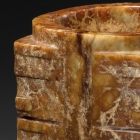J.J. Lally & Co., Oriental Art / New York City, New York
Menu4.
A NEOLITHIC RUSSET-BROWN AND YELLOW JADE CONG
Liangzhu Culture, circa 3300 – 2250 B.C.
the wide cylinder with square projecting panels around the sides angled across four corners and divided into two tiers and with short plain collars around the apertures at either end, the repeating panels each carved with a rudimentary stylized mask comprised of twin parallel ridges finely incised with horizontal lines above small circles with incised ‘v’ points at either side for the eyes and a short raised bar for the nose, the panels separated by deep grooves cut across the angle to end at the plain vertical band down the center of each side, the interior plain and polished, the jade of mottled reddish-brown and tan-yellow color.
Height 3 inches (7.6 cm)
Provenance
From the Collection of Eugene Meyer (1875-1959) and
Agnes E. Meyer (1887-1970)
A jade cong of slightly smaller size carved in a very similar shape and with closely comparable masks on the projecting corners, excavated from the Liangzhu site at Heyedi, Hai’ning city, Zhejiang province is illustrated by Gu (ed.), Zhongguo chutu yuqi quanji (Complete Collection of Jades Unearthed in China), Vol. 8, Zhejiang, Beijing, 2005, p. 35.
Another jade cong of similar form and size and with similar decoration, carved from mottled reddish-brown and tan-yellow jade in the British Museum is illustrated by Rawson (ed.), The British Museum Book of Chinese Art, London, 1993, p. 52, fig. 23, lower right.
Compare also the Liangzhu cong carved from similar mottled reddish-brown and tan-yellow jade collected by the Emperor Qianlong and made into a flower vase, now in the National Palace Museum, Taipei, illustrated in Ping pen feng hua: Ming Qing huaqi tezhan (The Enchanting Splendor of Vases and Planters: A Special Exhibition of Flower Vessels from the Ming and Qing Dynasties), Taipei, 2014, pp.144-145, II-07, with English description on pp. 265-266.
新石器時代 良渚玉琮 高 7.6 厘米
出處 邁爾夫婦舊藏
